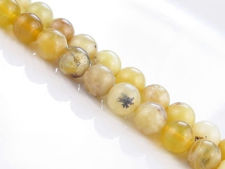- Shop per Size
- Shop per Shape
Opal Beads - Common Opal, Honey Opal, Pink Opal ...
Opal contains usually a high quantity of silicate. Due to its water content, up to 20 %, it is partially translucent. When it loses its water content, it becomes completely opaque. It sometimes displays a form of iridescence, but the much sought-after Peruvian opal does not show a play-of-color and is opaque.
Pink opal is among the hardest opals with a value of 6 on Moh's scale. It thanks its color to the surrounding clay ground and contains usually a high quantity of silicate.
Common opal, a variety of opal, comes in many colors and is usually opaque with no pseudochromatic optical effect. It is also known under many different names, for instances, banded opal is called agate opal, green opal is named prase opal, petrified wood replaced by opal becomes petrified opal, and so on.
Honey opal, although a common opal, is mostly translucent and shows rarely a play-of-color. Its colors go from golden yellow to orange brown.
Opal is said to be a calming stone which promotes also a peaceful sleep.




